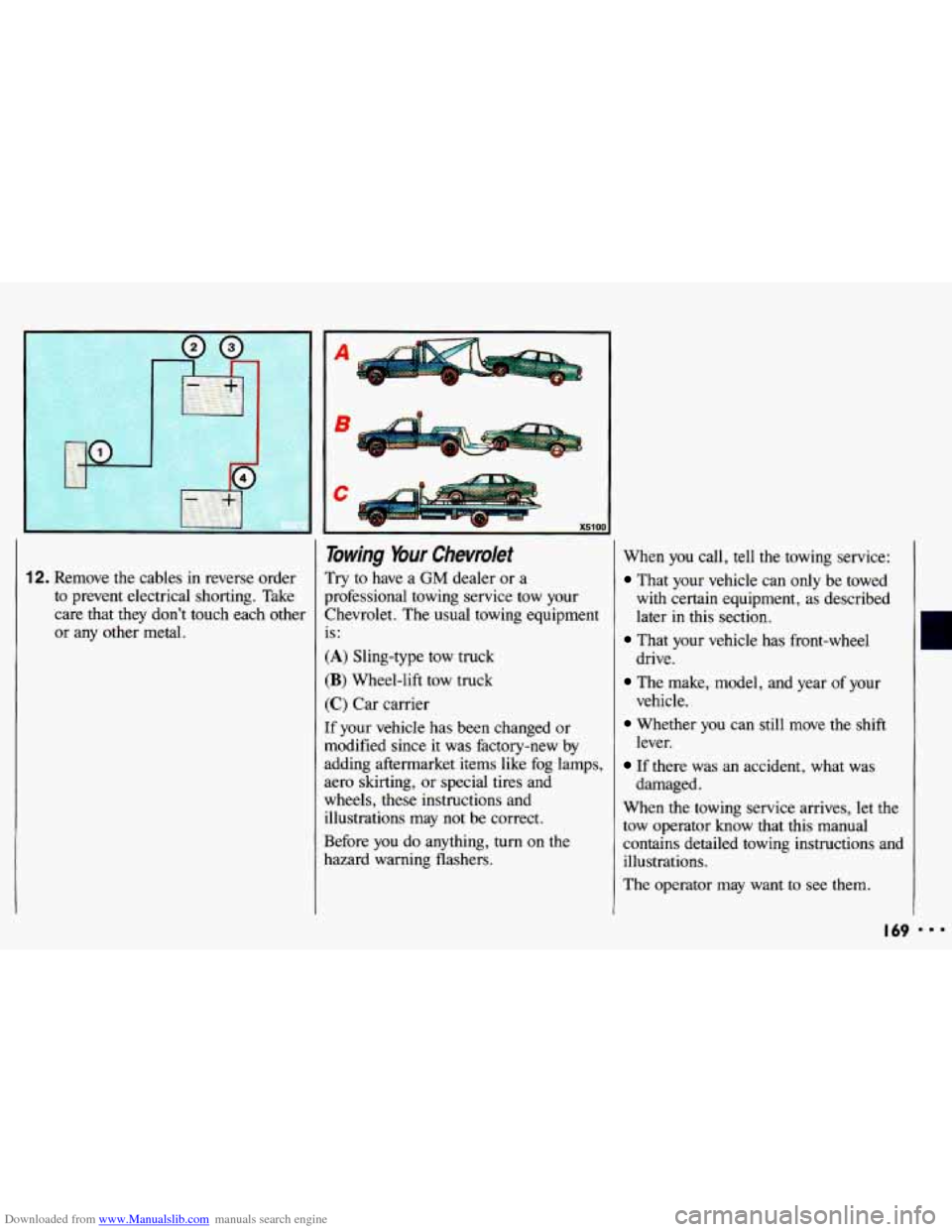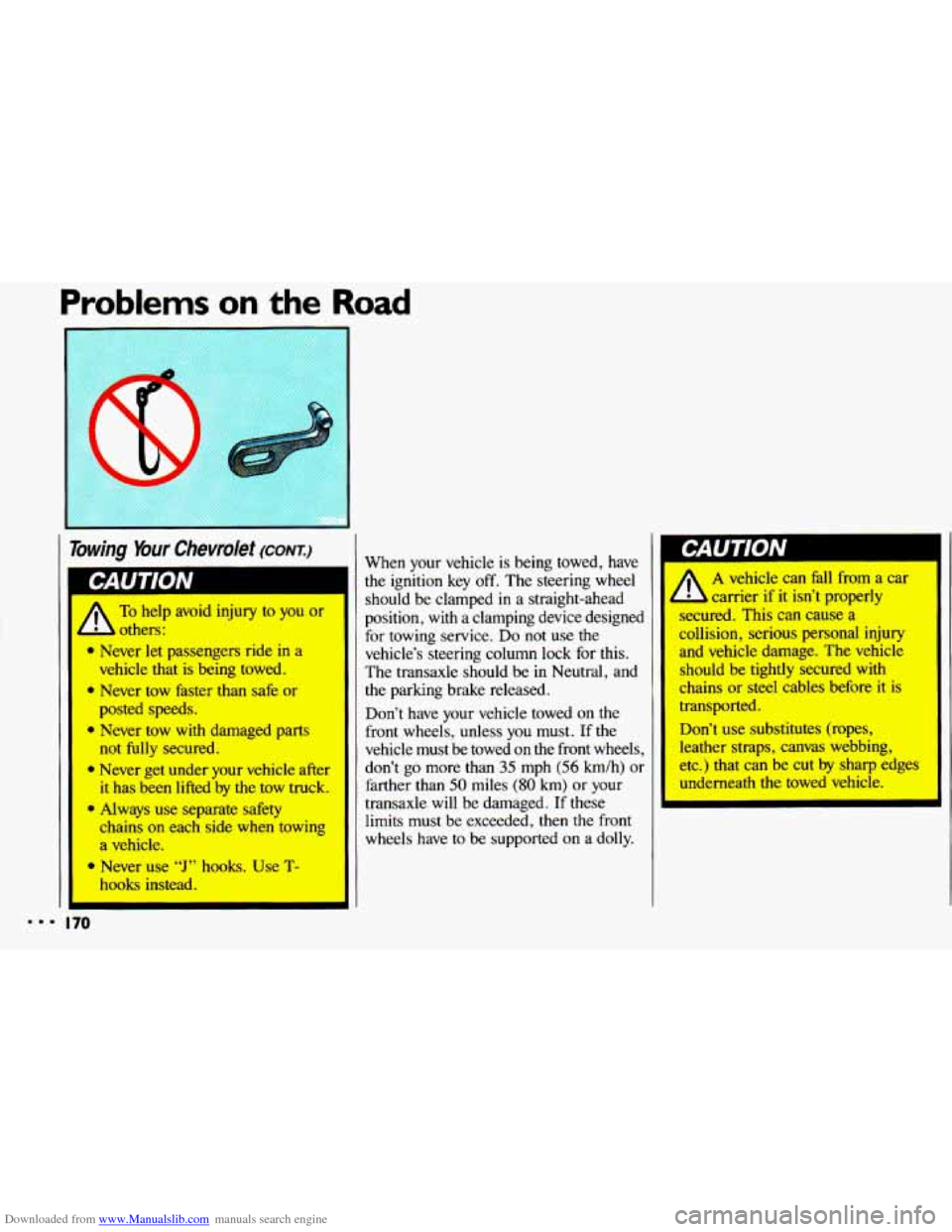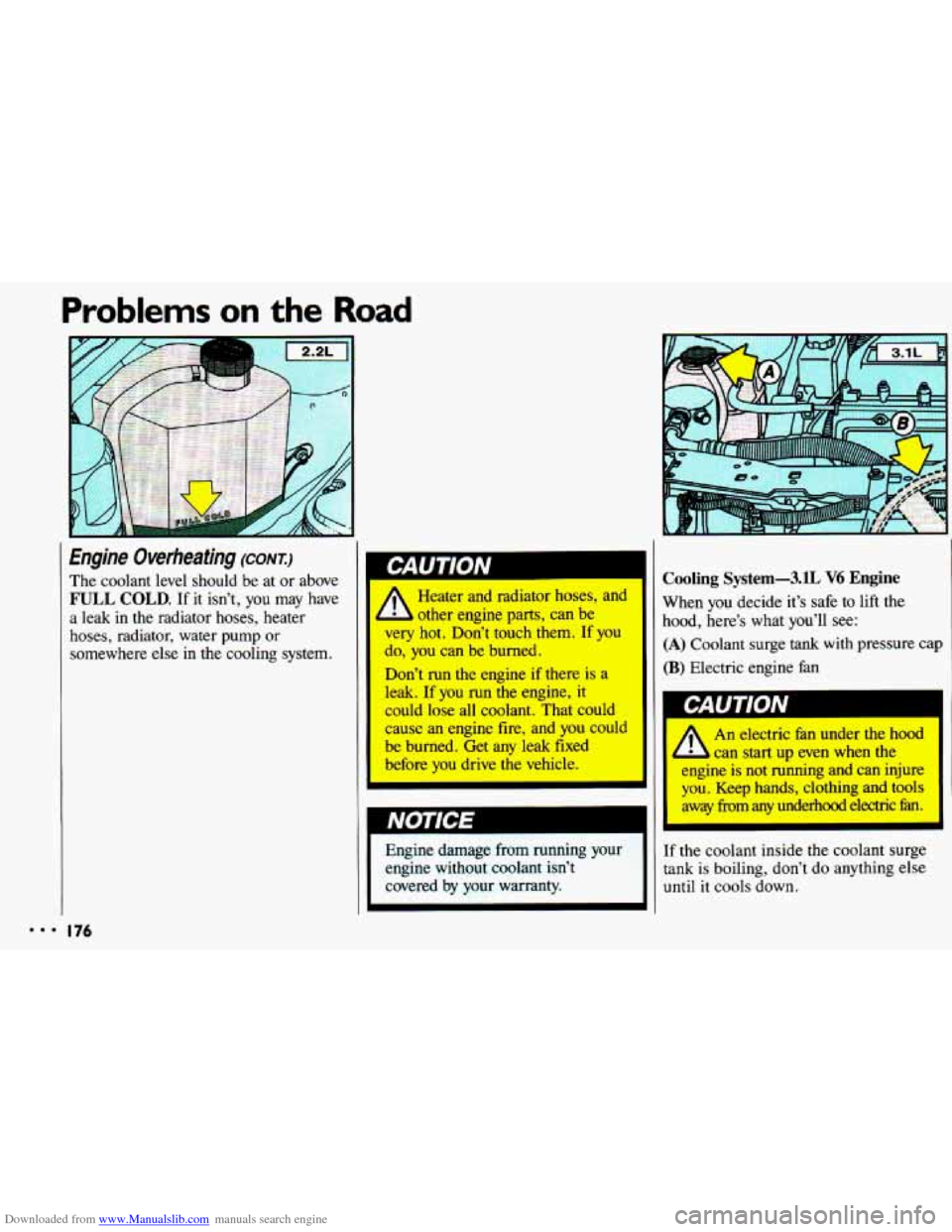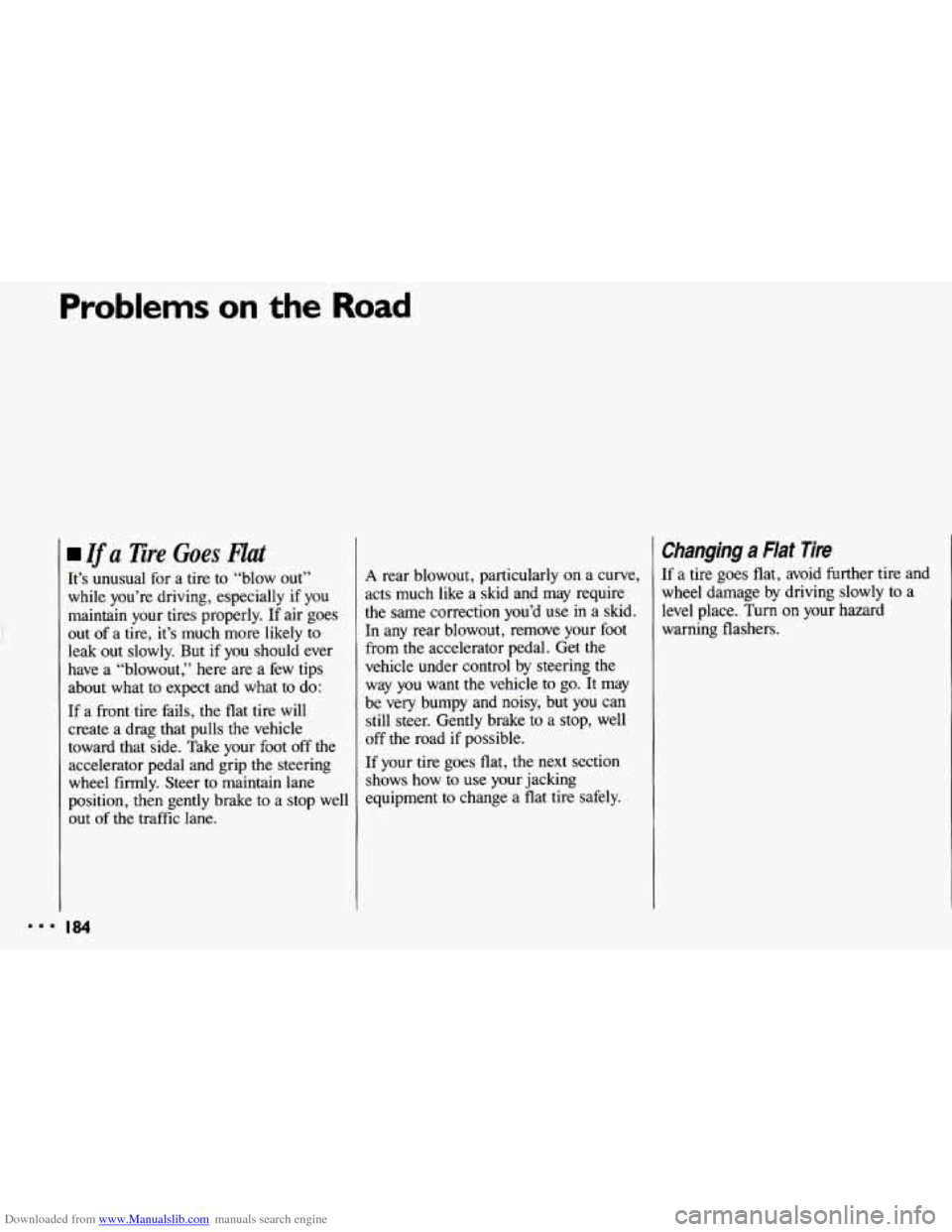Page 165 of 308
Downloaded from www.Manualslib.com manuals search engine Part 5
Problems on the Road
Hazard Warning Flashers .......................................... .164
Towing Your Chevrolet ........................................... .169
Engine Overheating
.............................................. ,174
If a Tire Goes Flat ............................................... .184
ComDact Spare Tire
.............................................. .191
Jumpstarting
....................................................164
ChangingaFlatTire .............................................. 184
If You’re
Stuck: In Sand, Mud, Ice or Snow ................... ...... .192
Here you’ll find what to do about
some problems that can occur on
the road.
I63
Page 171 of 308

Downloaded from www.Manualslib.com manuals search engine 12. Remove the cables in reverse order
to prevent electrical shorting. Take
care that they don't touch each other
or any other metal.
I
Towing Your Chevrolet
Try to have a GM dealer or a
professional towing service tow your
Chevrolet. The usual towing equipment
is:
(A) Sling-type tow truck
(B) Wheel-lift tow truck
(C) Car carrier
If your vehicle has been changed or
modified since it was factory-new by
adding aftermarket items like fog lamps,
aero skirting, or special tires and
wheels, these instructions and illustrations may not be correct.
Before you do anything, turn on the
hazard warning flashers. When
you call, tell the towing service:
That your vehicle can only be towed
with certain equipment,
as described
later
in this section.
drive.
vehicle. lever.
damaged.
That your vehicle has front-wheel
The make, model, and year of your
Whether you can still move the shift
If there was an accident, what was
When the towing service arrives, let the
tow operator know that this manual
contains detailed towing instructions and
illustrations.
The operator may want to see them.
I69
Page 172 of 308

Downloaded from www.Manualslib.com manuals search engine Problems on the Road
bwing Your Chevrolet (CONI)
To help avoid injury to you or
lers:
a Never let passengers ride in a
vehicle that is being towed.
a Never tow faster than safe or
posted speeds.
* Never tow with damaged parts
not fully secured.
* Never get under your vehicle after
it
has been lifted by the tow truck.
* Always use separate safety
chains on each side when towing
a vehicle.
Never use
“J” hooks. Use T-
hooks instead.
the ignition key off. The steering wheel
should be clamped
in a straight-ahead
position,
with a clamping device designed
for towing service. Do not use the
vehicle’s steering column lock for this.
The transaxle should be
in Neutral, and
the parking brake released.
Don’t have your vehicle towed on the
front wheels, unless
you must. If the
vehicle must be towed on the front wheels,
don’t go more than
35 mph (56 km/h) or
farther than
50 miles (80 km) or your
transaxle will be damaged. If these
limits must be exceeded, then
the front
wheels have to be supported on a dolly.
p-AU I IUN I
A vehicle can fall from a car
carrier if it isn’t properly
secured. This can cause a
collision, serious personal injury
and vehicle damage. The vehicle
should be tightly secured with
chains or steel cables before it is
transported.
Don’t use substitutes (ropes,
leather straps, canvas webbing,
etc.) that can be cut
by sharp edges
underneath
the towed vehicle.
A
mmm 170
Page 173 of 308
Downloaded from www.Manualslib.com manuals search engine Towing from the Front-
Vehicle
Hook-Up
Before hooking up to a tow truck, be
sure to read all the information
in
Towing Your Chevrolet earlier in this
section.
1. Attach T-hook chains into the slots in
the bottom of the floor pan, just
behind the front wheels, on both
sides.
Do not tow with sling-type
equipment or fascia damage will
occur. Use wheel lift
or car carrier
equipment. Additional ramping
may be required for car carrier
equipment. Use safety chains and
wheel straps.
I D m
I
When using wheel-lift equipmen1
towing over rough surfaces can
damage a vehicle.
To help avoid
this, install a towing dolly beneath
the wheels that would otherwise be
on the ground during the tow. This
will increase clearance between the wheel-lift equipment and
the
underbody of the towed vehicle.
I
Page 174 of 308
Downloaded from www.Manualslib.com manuals search engine Problems on the Road
Towing from the Front- Vehicle
Hook-Up (CONT.)
2. Attach a separate safety chain around
the outboard end of each lower
control arm.
I 72
Towing from the Rear-
Vehicle
Hook-Up
Before hooking up to a tow truck, be
sure to read all the information in
Towing Your Chevrolet earlier in this
section. Also be sure to use the proper
hook-up for your particular vehicle.
All Models:
1. Attach T-hook chains on both sides in
the slotted holes in the bottom of the
frame rail just ahead of the rear
wheels.
2. Position lower sling crossbar directly
under the rear bumper.
Page 175 of 308
Downloaded from www.Manualslib.com manuals search engine 2-24 Model: All Models:
NOTICE I
men using.w~&l-lift equipment,
towing
over rough surfices can
damage a vehicle. To help avoid
this, install a towing dolly beneath
the wheels that would otherwise be
on the ground during the tow. This
will increase clearance between the wheel-lift equipment and the
underbody
of the towed vehicle. I
3. Attach a separate safety chain to each
side
of the axle inboard of the spring.
Page 178 of 308

Downloaded from www.Manualslib.com manuals search engine Problems on the Road
Engine Overheating (CONT.)
The coolant level should be at or above
FULL COLD. If it isn't, you may have
a leak
in the radiator hoses, heater
hoses, radiator, water pump
or
somewhere else in the cooling system.
II Heater and radiator hoses, and
L other engine parts, can be
very hot. Don't touch them. If you
do, you can be burned.
Don't run the engine if there is a
leak. If you run the engine, it
could
lose all coolant. That could
cause
an engine fire, and you could
be burned. Get any leak fixed
before you drive the vehicle.
Engine damage from running
your
engine without coolant isn't
covered by your warranty.
I
Cooling System-3.1L V6 Engine
When you decide it's safe to lift the
hood, here's what you'll see:
(A) Coolant surge tank with pressure cap
(B) Electric engine fan
An electric fan under the hood
L can start up even when the
engine
is not running and can injl
you. Keep hands, clothing and tows
away hm any underhood electric f8n. I
If the coolant inside the coolant surge
tank is boiling, don't do anything else
until it cools down.
I.. I76
Page 186 of 308

Downloaded from www.Manualslib.com manuals search engine Problems on the Road
Zf a Tire Goes Flat
It’s unusual for a tire to “blow out”
while you’re driving, especially if you
maintain your tires properly.
If air goes
out of a tire, it’s much more likely
to
leak out slowly. But if you should ever
have a “blowout,” here are a few tips
about what to expect and what to do:
If a front tire fails, the flat tire will
create a drag that pulls the vehicle
toward that side. Take your foot off the accelerator pedal and grip the steering
wheel firmly. Steer to maintain lane
position, then gently brake
to a stop well
out of
the traffic lane.
I 84
A rear blowout, particularly on a curve,
acts much like a skid and may require
the same correction you’d use in a skid.
In any rear blowout, remove your foot
from the accelerator pedal. Get the
vehicle under control by steering the
way
you want the vehicle to go. It may
be very bumpy and noisy, but you can
still steer. Gently brake
to a stop, well
off the road
if possible.
If your tire goes flat, the next section
shows how
to use your jacking
equipment to change
a flat tire safely.
Changing a Flat Tire
If a tire goes flat, avoid further tire and
wheel damage by driving slowly to a
level place.
Turn on your hazard
warning flashers.